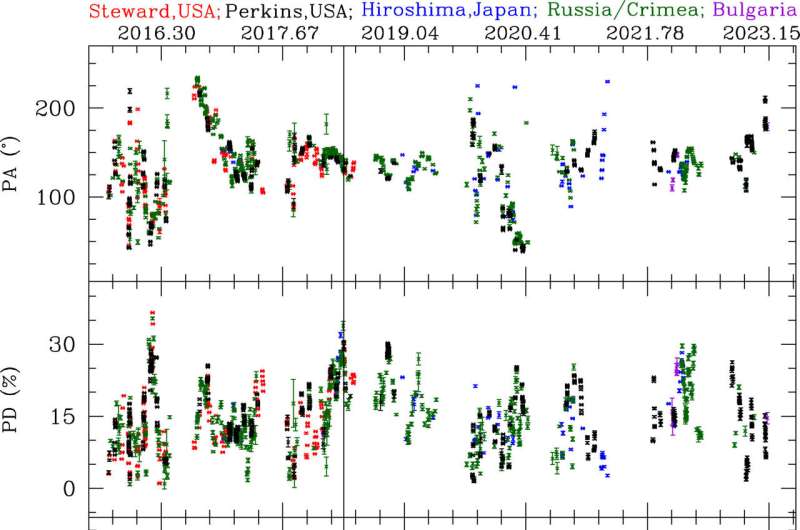This article has been reviewed according to Science X's editorial process and policies. Editors have highlighted the following attributes while ensuring the content's credibility:
fact-checked
peer-reviewed publication
trusted source
proofread
Researchers discover emission from secondary black hole in binary system of blazar OJ 287

OJ 287 is recognized as a binary black hole system with a slowly spiraling orbit caused by loss of energy to gravitational radiation. This energy loss was already confirmed in 2008. Subsequent measurements have confirmed this orbit solution, most recently in 2023.
Until now, the signals arising from the binary system have been associated either with the ultramassive primary black hole or with the gas accretion disk surrounding it.
However, an international research group has recently acquired new evidence related to this system by observing signals arising directly from the smaller (secondary) black hole. Using this evidence, the researchers claim they are able to "see" the secondary black hole for the first time by using measurements of polarized light coming from OJ 287.
The study was published in The Astrophysical Journal Letters on Oct. 30.
Scientists have known for more than 50 years that the light of OJ 287 is polarized. However, making full use of this polarized signal requires monitoring its variation over time.
For the current study, the researchers have completed the most comprehensive polarization monitoring to date by using seven telescopes in the U.S., Japan, etc., with special equipment for measuring polarization.
"We found a general rule which OJ 287 follows: the increase in the total optical emission leads to increase in polarization, and vice versa," said Prof. Alok C. Gupta, the recent PIFI visiting scholar at Shanghai Astronomical Observatory of the Chinese Academy of Sciences, the first author of the study, as well as a professor at India's Aryabhatta Research Institute of Observational Sciences.
Interestingly, however, there are times when this rule fails. Models show that the failures are likely to be associated with two overlapping signals, one coming from the primary black hole and the other coming from the secondary. This evidence for two separate signals appears most strongly in the polarization of light, which is expected to be quite different when two sources are contributing, rather than just one single source. The general rule of polarization variation is violated in the two-signal case.
Since the two black holes are so close to each other in the sky, only about 10 microarcseconds apart, they necessarily appear as a single point of light. "Only by using the polarization of light can we be reasonably sure that really two sources, two black holes, contribute to the total light signal," said Prof. Gupta.
"The violations of the general rule appear at times when we expect the secondary black hole to be active in the binary model: In general, the signal from the smaller secondary is not detectable. The activity of the secondary is related to its approach toward the primary disk of gas, which provides matter to the secondary to feed on."
The feeding leads to bright signals, all the way from radio to gamma-rays. The latter signals have been recently used to verify the orbit model.
"Now the polarization data confirms this interpretation. As a result, we are confident OJ 287 is really an ultramassive binary black hole system, and signals from both components can be separated despite their closeness to each other in the sky," said Prof. Gu Minfeng from Shanghai Astronomical Observatory of the Chinese Academy of Sciences, co-author of the study.
More information: Alok C. Gupta et al, Quasi-simultaneous Optical Flux and Polarization Variability of the Binary Super Massive Black Hole Blazar OJ 287 from 2015 to 2023: Detection of an Anticorrelation in Flux and Polarization Variability, The Astrophysical Journal Letters (2023). DOI: 10.3847/2041-8213/acfd2e
Journal information: Astrophysical Journal Letters
Provided by Chinese Academy of Sciences



















